Презентация great depression


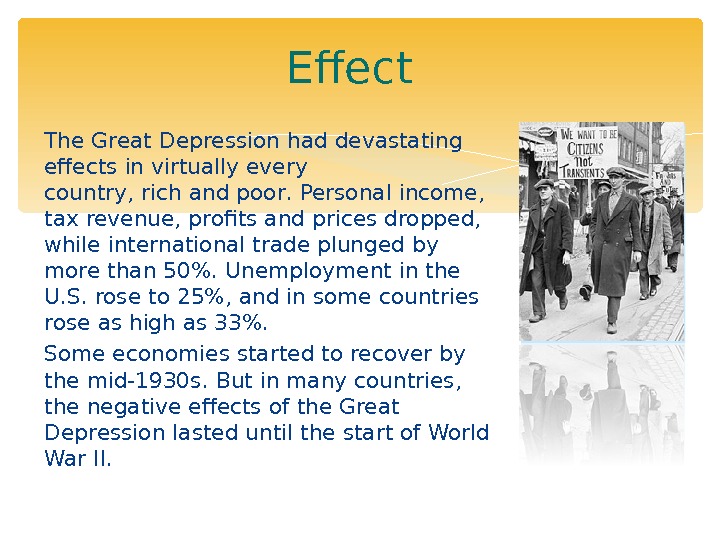


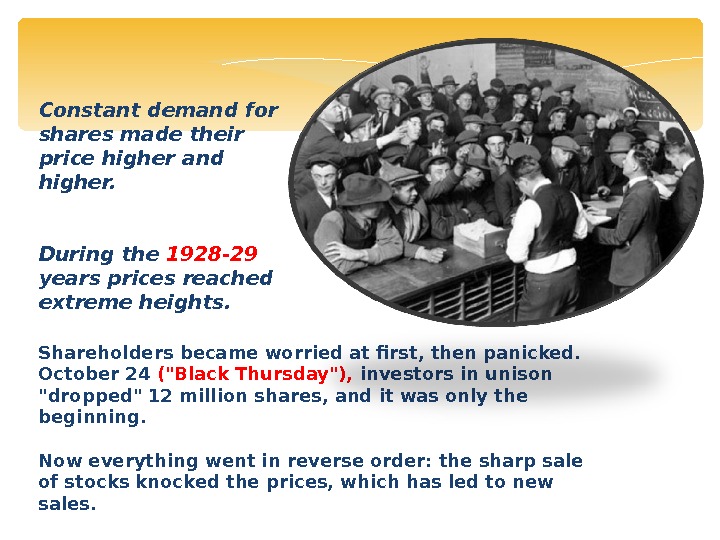
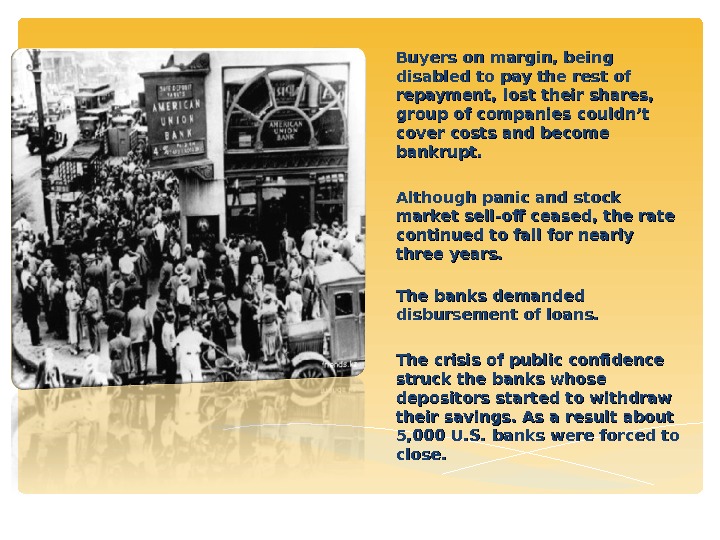





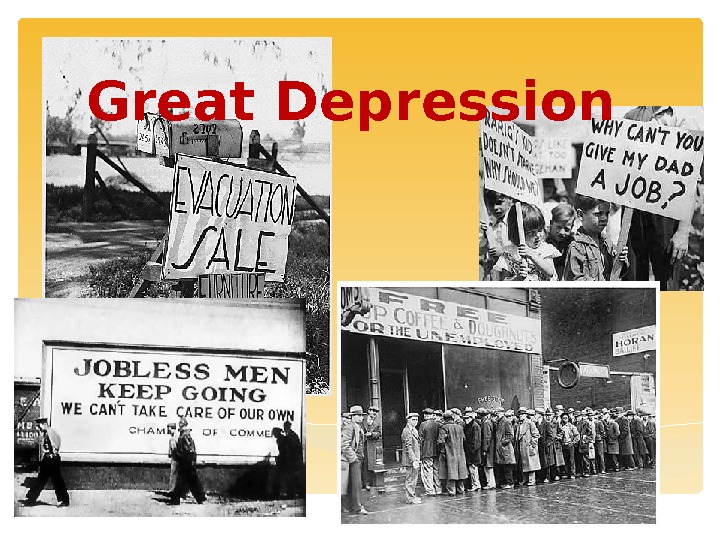
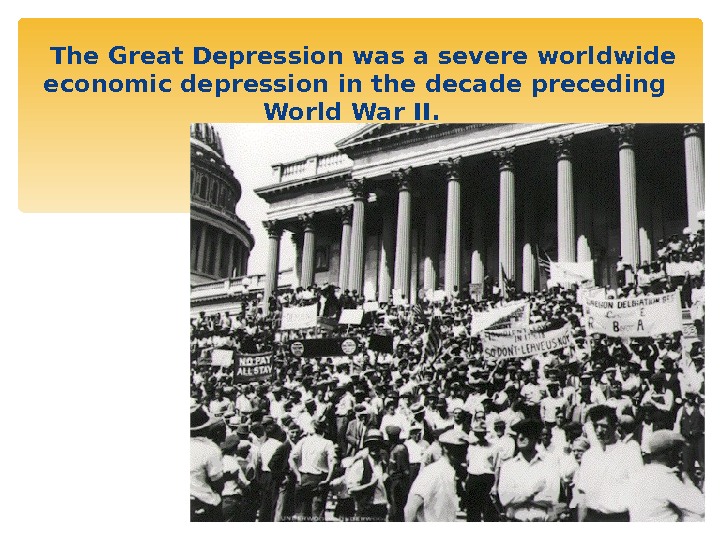


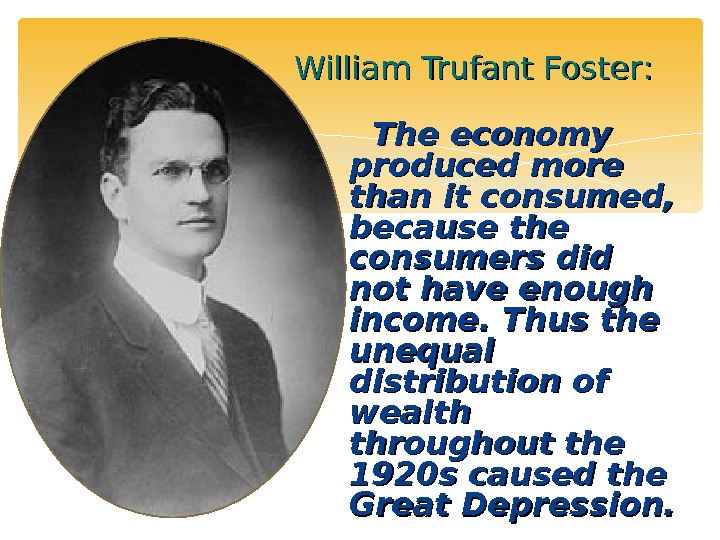
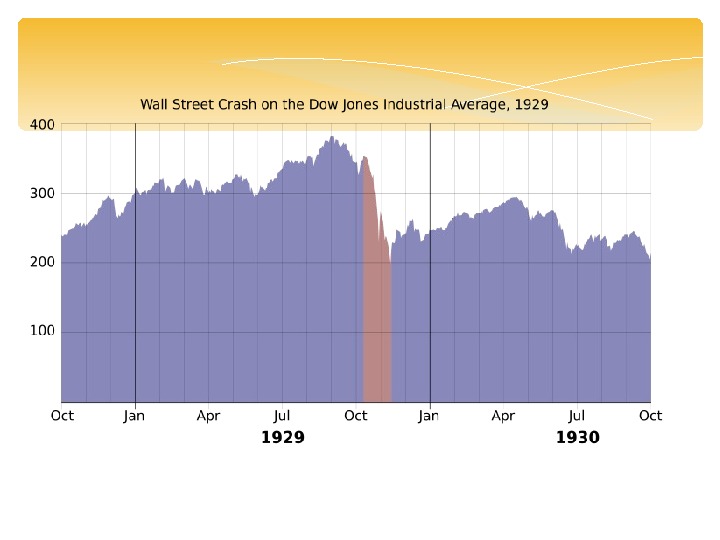
- Размер: 6.3 Mегабайта
- Количество слайдов: 17
Описание презентации Презентация great depression по слайдам
 The Great Depression was a severe worldwideeconomic crisis in the decade preceding. World War II. The timing of the Great Depression varied across nations, but in most countries it started in about 1929 and lasted until the late 1930 s or early 1940 s. It was the longest, most widespread, and deepest depression of the 20 th century.
The Great Depression was a severe worldwideeconomic crisis in the decade preceding. World War II. The timing of the Great Depression varied across nations, but in most countries it started in about 1929 and lasted until the late 1930 s or early 1940 s. It was the longest, most widespread, and deepest depression of the 20 th century.
 Effect The Great Depression had devastating effects in virtually every country, rich and poor. Personal income , tax revenue, profits and prices dropped, while international trade plunged by more than 50%. Unemployment in the U. S. rose to 25%, and in some countries rose as high as 33%. Some economies started to recover by the mid-1930 s. But i n many countries, the negative effects of the Great Depression lasted until the start of World War II.
Effect The Great Depression had devastating effects in virtually every country, rich and poor. Personal income , tax revenue, profits and prices dropped, while international trade plunged by more than 50%. Unemployment in the U. S. rose to 25%, and in some countries rose as high as 33%. Some economies started to recover by the mid-1930 s. But i n many countries, the negative effects of the Great Depression lasted until the start of World War II.
 Start of the Great Depression The Great Depression started with sudden devastating collapse of US stock market prices on October 29, 1929, known as Black Tuesday, which was the most devastatingstock market crashin the history of the Unated States. It signaled the beginning of the 10 -year Great Depression.
Start of the Great Depression The Great Depression started with sudden devastating collapse of US stock market prices on October 29, 1929, known as Black Tuesday, which was the most devastatingstock market crashin the history of the Unated States. It signaled the beginning of the 10 -year Great Depression.
 Market collapse and financial panic
Market collapse and financial panic
 Shareholders became worried at first, then panicked. October 24 («Black Thursday»), investors in unison «dropped» 12 million shares, and it was only the beginning. Now everything went in reverse order: the sharp sale of stocks knocked the prices, which has led to new sales. Constant demand for shares made their price higher and higher. During the 1928 -29 years prices reached extreme heights.
Shareholders became worried at first, then panicked. October 24 («Black Thursday»), investors in unison «dropped» 12 million shares, and it was only the beginning. Now everything went in reverse order: the sharp sale of stocks knocked the prices, which has led to new sales. Constant demand for shares made their price higher and higher. During the 1928 -29 years prices reached extreme heights.
 Buyers on margin, being disabled to pay the rest of of repayment, lost their shares, group of companies couldn’t cover costs and become bankrupt. Although panic and stock market sell-off ceased, the rate continued to fall for nearly three years. The banks demanded disbursement of loans. The crisis of public confidence struck the banks whose depositors started to withdraw their savings. As a result about 5, 000 U. S. banks were forced to close.
Buyers on margin, being disabled to pay the rest of of repayment, lost their shares, group of companies couldn’t cover costs and become bankrupt. Although panic and stock market sell-off ceased, the rate continued to fall for nearly three years. The banks demanded disbursement of loans. The crisis of public confidence struck the banks whose depositors started to withdraw their savings. As a result about 5, 000 U. S. banks were forced to close.
 Overproduction in rural economy
Overproduction in rural economy
 The core of the problem was the immense disparity between the country’s productive capacity and the ability of people to consume. Great innovations in productive techniques during and after the war raised the output of industry beyond the purchasing capacity of U. S. farmers and wage earners
The core of the problem was the immense disparity between the country’s productive capacity and the ability of people to consume. Great innovations in productive techniques during and after the war raised the output of industry beyond the purchasing capacity of U. S. farmers and wage earners
 Farm production outpaced demand to such a high degree that the price of wheat dropped from $1. 37 to 61 cents a bushel in 1930. Prices were so low that wheat farmers were losing $1. 50 on every acre they planted. Some farmers were destroying agricultural goods to try to raise prices by reducing supply
Farm production outpaced demand to such a high degree that the price of wheat dropped from $1. 37 to 61 cents a bushel in 1930. Prices were so low that wheat farmers were losing $1. 50 on every acre they planted. Some farmers were destroying agricultural goods to try to raise prices by reducing supply
 Over one million families lost their farms between 1930 and
Over one million families lost their farms between 1930 and
 The New Deal years were characterized by a belief that greater regulation would solve many of the country’s problems. In 1933, for example, Congress passed the Agricultural Adjustment Act (AAA) to provide economic relief to farmers. The AAA had at its core a plan to raise crop prices by paying farmers a subsidy to compensate for voluntary cutbacks in production The New Deal
The New Deal years were characterized by a belief that greater regulation would solve many of the country’s problems. In 1933, for example, Congress passed the Agricultural Adjustment Act (AAA) to provide economic relief to farmers. The AAA had at its core a plan to raise crop prices by paying farmers a subsidy to compensate for voluntary cutbacks in production The New Deal
 Great Depression
Great Depression
 The Great Depression was a severe worldwide economic depression in the decade preceding World War II.
The Great Depression was a severe worldwide economic depression in the decade preceding World War II.
 Cities all around the world were hit hard, especially those dependent on heavy industry. Construction was virtually halted in many countries. And some economies started to recover by the mid-1930 s. In many countries, the negative effects of the Great Depression lasted until the start of World War II. Industrial production United States – 46% Great Britain – 23% France – 24% Germany – 41%
Cities all around the world were hit hard, especially those dependent on heavy industry. Construction was virtually halted in many countries. And some economies started to recover by the mid-1930 s. In many countries, the negative effects of the Great Depression lasted until the start of World War II. Industrial production United States – 46% Great Britain – 23% France – 24% Germany – 41%
 FINANCIAL INEQUALITY in the period of Great Depression
FINANCIAL INEQUALITY in the period of Great Depression
 William Trufant Foster : : TT he economy produced more than it consumed, because the consumers did not have enough income. Thus the unequal distribution of wealth throughout the 1920 s caused the Great Depression.
William Trufant Foster : : TT he economy produced more than it consumed, because the consumers did not have enough income. Thus the unequal distribution of wealth throughout the 1920 s caused the Great Depression.


